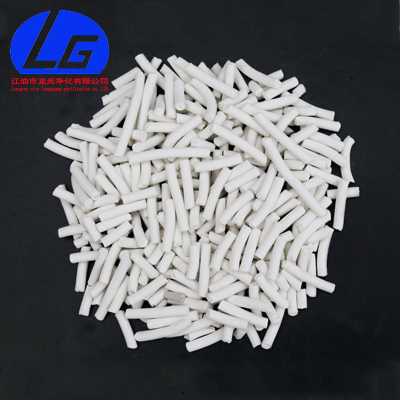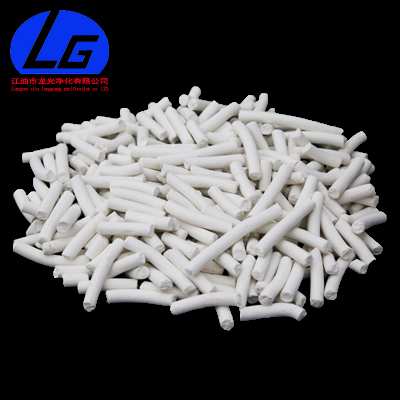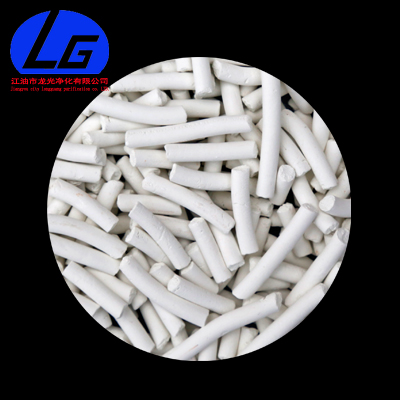Parameters:
Item | Unit of Measurement | Indicator | Remark |
MODEL |
| LG-02 |
|
color |
| White, gray |
|
Shape |
| Column |
|
Working sulfur capacity | Wt%(30℃) | ≥10 |
|
Desulfurization accuracy | ppm | 0.1 |
|
Spec. | mm | Ф(4~5)×(5~15) |
|
Lateral pressure strength | N/cm | ≥35 |
|
Bulk density | kg/l | 0.9±0.05 |
|
Specific Surface | m2/g | ≥60 |
|
ZnO | % | ≥80 |
|
SERVICE CONDITIONS |
Running airspeed | h-1 | 500 ~ 3,000 (gas) 0.5 ~ 3 (liquid) |
|
Traumatic | Mpa | Normal pressure ~30.0 |
|
Temperature during use | ℃ | 20~80 |
|
Chemical reaction and characteristics:
ZnO+H2S= ZnS+H2O
CS2+4H2=2H2S+CH4
COS+H2=H2S+CO
COS+ZnO=ZnS+CO2
The desulfurizer can not only absorb a large amount of inorganic sulfur (H2S) in the gas, but also convert some simple organic sulfur (COS, CS2) absorbed. It can be used not only at high temperature (350-450°C) but also at low temperature ( 100 ~ 300 °C), and it works well especially at higher temperatures.
normal packaging:
Woven bag lined with plastic bag. (40 kg/bag, 700-900 kg/bag)
Other packaging:
According to customer requirements, plastic buckets, iron buckets and other packaging can be provided, but a certain packing fee is charged.
Transport and Storage
1. During transportation, it is necessary to ensure that the container does not leak, collapse, fall or is not damaged. It can not be storaged and transported with oxidizer, etc. During transportation, it should be protected from sun exposure, rain or high temperature.
2. Need storing in a cool and ventilated warehouse. Keep away from sparks and heat sources. Should be kept away from oxidizer, and never store them together. The storage area shall have applicable material holding apparatus to receive leakages.
I. Loading Method
The dust in the desulfurizer should be sieved before loading. Before loading, check the inside of the chute to see if the internal installation is correct and if the interior is clean. No residual desulfurizer dust is allowed in the chute, otherwise the dust will be carried into the catalyst layer by the airflow next time when running.
From the bottom of the desulfurization chute to the tangent line, alumina balls of Φ15 to 20 mm should be installed. The discharge pipe should be also filled with alumina balls. A layer of wire mesh screen with 8×8 mesh ×1.6 mm need to be placed on the alumina balls and desulfurizer should be installed on the screen. A layer of screen is placed on the top and pressed with alumina balls of Φ15-20 mm. A layer of sieve plate is pressed on the alumina balls. The discharge pipe for desulfurizer shall be protruded from the upper surface of the lower screen to facilitate discharging.
The desulfurizer should be loaded on sunny days to avoid moisture. The packing should be as uniform as possible so that fluctuations in the pressure decay and non-uniformity in the air flow distribution can be minimized.
The desulfurizer can be sent from the drum to the desulfurization chute by any convenient method, but do not fall it freely from a height over 600 mm. Smaller containers can be used to feed from the access hole, or a chute can be placed to connect the cloth bag. The other end of the cloth bag is placed on the bed. One person pulls the cloth bag in the chute and evenly spreads it around. Persons working in the bed area should wear dust masks. They should stand on a wooden board to distribute gravity evenly on the desulfurizer. Alumina balls should be lifted by bucket and cannot be slipped with cloth bags for loading. After the desulfurizer is filled and checked, the screws for flange covers should be tightened.
II. Start-up Procedures
1. Blowing of Desulfurizer Dusts
In order to remove the dusts in desulfurizer, gas is used to blow off the dusts, and the blown off gas may be nitrogen (or air) or feed gas.
2. Gas Tight Test and Rreplacement of Feed Gas System
Gas tight test is carried out with air (or nitrogen), and all valves and flanges are to be qualified for gas tightness. If air is used for gas tight test, replace with feed gas after the pressure is relieved, and the system should be pressurized to the required pressure. Do not use steam as a displacement medium, because the condensate surely will damage the desulfurizer. Temporarily unused valves should be sealed with baffles.
3. Temperature Rise Conditions
The temperature rise conditions of Longguang zinc oxide desulfurizer Type LG-02 is not very strict. The temperature rise medium is directly heated with inert gas or purified feed gas. For example, the zinc oxide desulfurizer Type LG-02 is used as a kind of "detection" for the low temperature shift catalyst or methanation catalyst. Because there is no problem of reduction of zinc oxide, the heating rate and conditions are based on low temperature shift catalyst or methane catalyst.
III. Stop Procedures
1. Accidental Short-term Stop
During the stop, the feed gas must be used to maintain the positive pressure of the desulfurization chute to prevent air or other oxygen-containing gas from entering the desulfurization chute to oxidate the desulfurizer (Be careful to prevent air being inhaled as a result of the negative pressure due to the volume shrinkage of the cooling gas). For the next time running, feed gas can be directly used to quickly warm up to normal operation.
2. Replacement of Desulfurizer When Normal Stop
The desulfurizer to be discharged is already reduced or vulcanized, and it will be oxidized and even spontaneously ignited in contact with air in this state, resulting in overheating or even damage to the equipment. Before discharging the desulfurizer, it is necessary to first cool the desulfurizer with steam (or natural cooling) to 120-150°C, and then replace the system with nitrogen, and continue cooling to below 60°C. The chute for discharged catalyst is placed at the discharge outlet of the desulfurization bed, and open the inlet hole on the top of furnace, and then spray the desulfurizer with water to make it wet. Finally, under the protection of nitrogen, open the cover plate of the discharge outlet of the desulfurizer and the unload the inner baffle.
When all the desulfurizer are discharged, wash the equipment with water gradually down from the top of the desulfurization tower, and the aluminium oxide balls can be completely replaced or reused after sieved and washed. Residues of dusts or particles of the spent desulfurizer are not allowed in equipment or pipelines.
 Current location:Home - Product Center - Zinc oxide desulfurizer - LG-02 Type Zinc Oxide Desulfurizer
Current location:Home - Product Center - Zinc oxide desulfurizer - LG-02 Type Zinc Oxide Desulfurizer





 Sales hot-line:0816-3736605
Sales hot-line:0816-3736605 E-mail:jysongwei@126.com
E-mail:jysongwei@126.com Address:No. 772, Laojun Road, Jiangyou, Sichuan
Address:No. 772, Laojun Road, Jiangyou, Sichuan

 QQ
QQ Tel
Tel Message
Message Share
Share Top
Top